Overview
The article addresses the emotional challenges that healthcare providers often encounter in their documentation practices. It highlights the overwhelming administrative burdens that can detract from the quality of patient care. By providing essential examples of dental SOAP notes, this piece aims to guide healthcare providers towards effective documentation practices that not only enhance their workflow but also improve patient outcomes.
Structured documentation through the SOAP framework is emphasized as a vital tool for ensuring comprehensive, clear, and compliant records. This structured approach not only alleviates some of the stress associated with documentation but also fosters a nurturing environment for patient care. Furthermore, the role of AI in streamlining the documentation process is discussed, showcasing how it can significantly improve efficiency and free up valuable time for healthcare providers.
By adopting these practices, providers can focus more on what truly matters—their patients. Imagine the relief of having a more manageable documentation process that allows for deeper connections with those in your care. As you explore these examples and solutions, consider how implementing them can transform your daily routine and enhance the quality of care you provide.
We encourage you to engage with these practices and reflect on how they can benefit your work. Together, we can create a more compassionate healthcare environment that prioritizes patient care while supporting the dedicated professionals behind it.
Introduction
The landscape of dental care is rapidly evolving, and it’s essential to recognize the emotional challenges faced by healthcare professionals. Many are increasingly burdened by administrative tasks that take time away from meaningful patient interactions. This situation can lead to frustration and a sense of disconnect from the very reason they entered the field.
Amid these challenges, the integration of artificial intelligence (AI) into dental documentation emerges as a transformative solution. By streamlining processes, AI not only alleviates the administrative load but also enhances the quality of patient care. How can dental practitioners leverage AI-driven tools to improve efficiency while elevating the care they provide?
This article delves into essential dental SOAP note examples, exploring the myriad benefits of AI in documentation. We will discuss best practices for effective record-keeping, encouraging you to consider how these tools can empower your practice and foster deeper connections with your patients.
CosmaNeura: AI-Driven Documentation for Dental SOAP Notes
In today's fast-paced healthcare environment, many dental professionals find themselves overwhelmed by administrative tasks. This burden can detract from the time and attention they wish to dedicate to their patients. CosmaNeura understands these challenges and offers a compassionate solution by utilizing cutting-edge AI technology to transform the documentation process for a dental soap note example.
By automating routine tasks, CosmaNeura allows dental professionals to focus more on client care rather than getting lost in paperwork. Imagine being able to spend more quality time with your patients, enhancing their experience and outcomes. This integration not only boosts efficiency but also addresses the rising costs of healthcare, easing financial pressures on both individuals and providers.
Moreover, CosmaNeura ensures that documentation adheres to ethical standards, aligning with the values of faith-focused healthcare providers. With features like real-time transcription and smart data analysis, it sets a new benchmark in practice management. Every interaction is meticulously documented and readily accessible, fostering a supportive environment for both providers and patients.
As we look to the future, the implementation of AI in oral care practices is on the rise. In 2024, around 18% of oral health professionals are expected to incorporate AI modules into their workflows, showcasing a growing recognition of AI's role in improving operational efficiency and client outcomes. Practices utilizing Document Services AI have reported an astounding 91% reduction in document processing time, highlighting the significant efficiency gains achievable through this integration.
Additionally, 66% of physicians have indicated they are using healthcare AI in 2024, underscoring the broader trend of AI adoption in healthcare and its ethical implications. This is an opportunity for dental professionals to embrace technology that not only streamlines their processes but also enhances the care they provide. Are you ready to explore how AI can transform your practice and improve patient care?
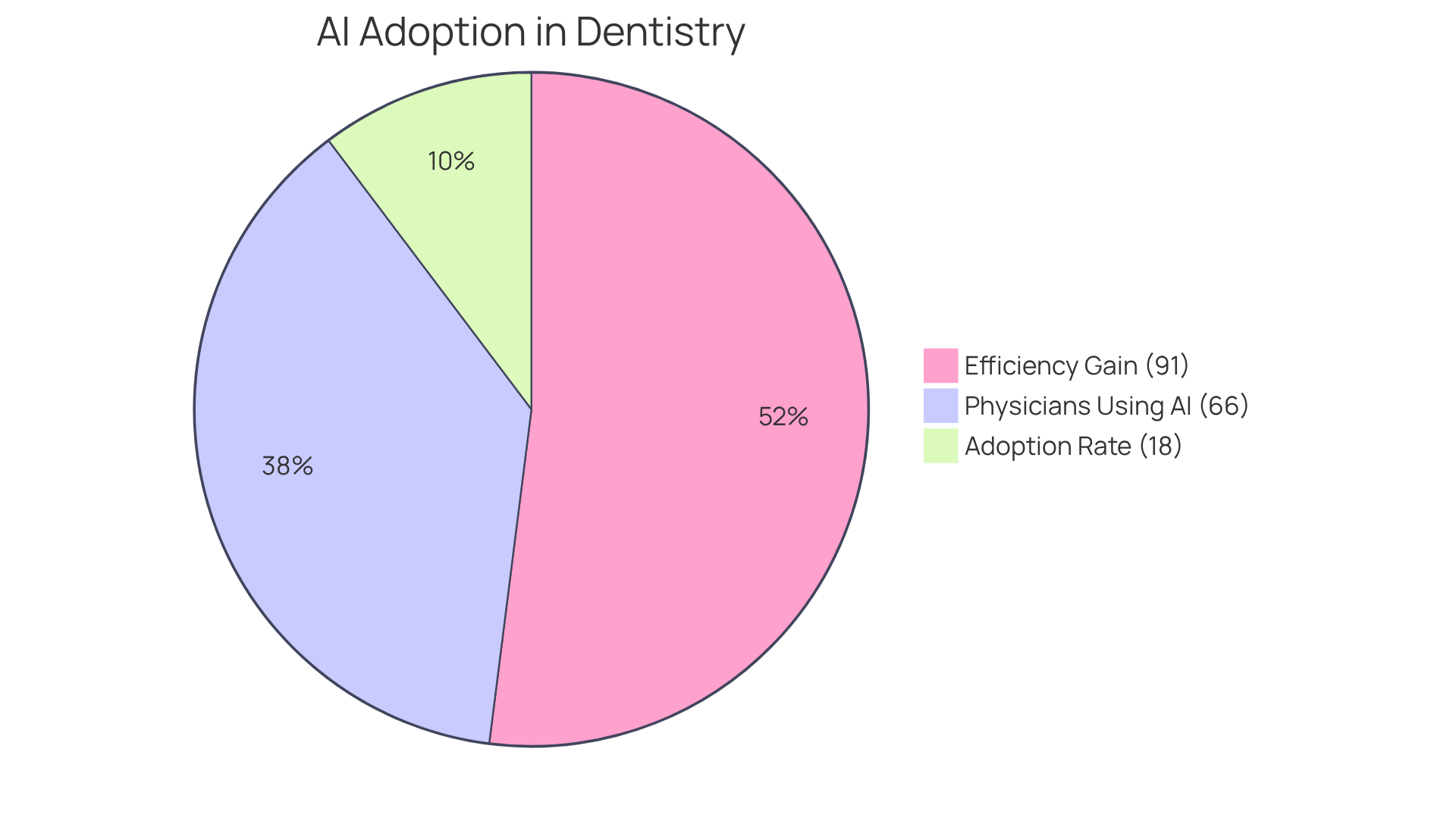
SOAP Framework: Essential Structure for Dental Documentation
The dental soap note example illustrates the essential tool of the SOAP framework in dental documentation, which consists of four vital components: Subjective, Objective, Assessment, and Plan. Each section plays a crucial role in ensuring comprehensive patient care, and leveraging generative AI can further enhance this process:
- Subjective (S): Here, we capture the patient's reported symptoms and concerns, providing valuable insights into their experience and emotional state. For instance, if an individual shares a 50% reduction in pain after taking ibuprofen, this information is critical for understanding their condition. Generative AI can assist in documenting these subjective reports more efficiently, ensuring that no critical details are overlooked.
- Objective (O): In this section, clinicians document measurable data, including vital signs and clinical findings, to support an evidence-based approach. This could involve recording specific clinical measurements or observations made during the examination. AI tools can automate the collection and analysis of this data, reducing the time spent on administrative tasks such as managing medical records, allowing clinicians to focus more on patient care.
- Assessment (A): This part synthesizes the subjective and objective data to formulate a diagnosis or clinical impression. For example, identifying distal occlusal caries based on the collected data allows for targeted treatment planning. AI can enhance diagnostic precision by examining patterns in individual data, leading to more informed clinical choices.
- Plan (P): The plan outlines the proposed treatment steps, follow-up care, and education for individuals, ensuring a comprehensive approach to management. This may include recommendations for further treatment, timelines, and preventive measures. AI can help create tailored care plans based on the individual's unique requirements and history, enhancing engagement and compliance with treatment.
Using a dental soap note example demonstrates that employing the SOAP framework not only increases the clarity of records but also enhances communication among healthcare professionals. This ultimately results in better health outcomes and streamlined billing processes. Properly completed SOAP records can serve as proof that treatment was necessary, and adhering to the gold standard benchmark score of 29 for an ideal SOAP entry emphasizes the importance of high-quality documentation. Moreover, prompt revisions to SOAP notes enhance precision and reduce discrepancies, while the standardized format facilitates quicker examination of medical histories. By implementing these practices and integrating AI, healthcare providers can reclaim valuable time in their practice and facilitate quicker reimbursement from insurance claims.
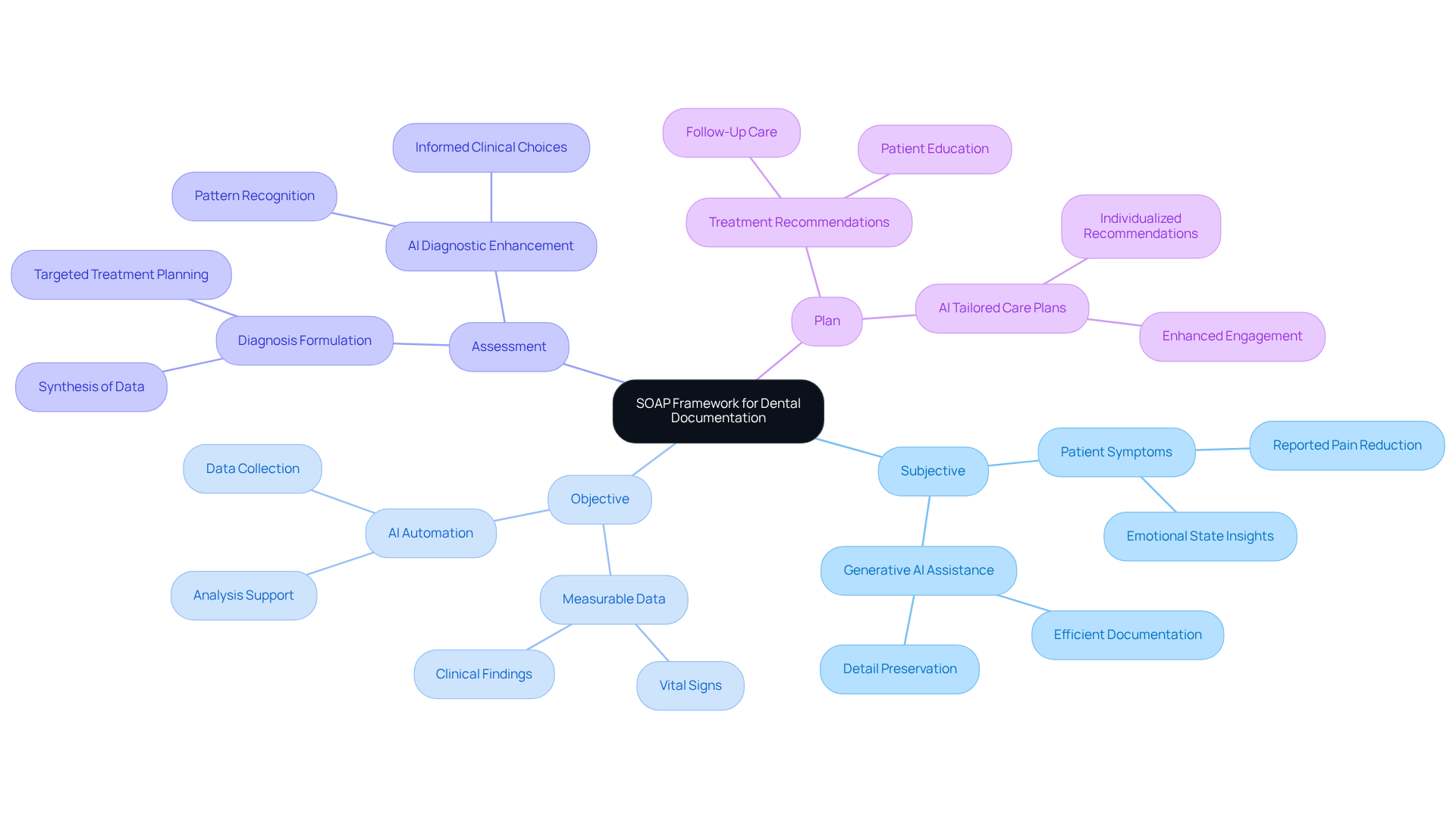
Example 1: SOAP Note for Toothache Management
Subjective: The individual shares a troubling experience of severe pain in the lower right molar, expressing that the discomfort has worsened over the past two days. It's important to note that the patient does not report any fever or swelling, which can be a relief. According to the CDC, nearly 90% of adults aged 20 to 64 have faced tooth decay, a common challenge that many can relate to.
Objective: During the clinical examination, tenderness is observed upon percussion of the lower right molar, with visible caries present. Thankfully, there are no signs of swelling or systemic infection. The presence of caries is significant, as untreated tooth decay is recognized as the most prevalent health condition globally, impacting approximately 2 billion individuals.
Evaluation: The diagnosis indicates tooth decay with a potential pulpitis in the lower right molar, a frequent issue that can lead to considerable pain and necessitates prompt attention. The economic impact of oral health issues is substantial, leading to around 34 million lost school hours and 92 million lost work hours annually.
Plan: It is recommended to proceed with the extraction of the affected tooth. Prescribing analgesics will aid in effective pain management, and scheduling a follow-up appointment will ensure the extraction is performed in a timely manner. This approach aligns with optimal standards for documenting caries treatment, which can be illustrated by a dental soap note example that underscores the importance of thorough assessment and clear communication. As emphasized by the National Institute of Dental and Craniofacial Research, effective documentation is crucial in managing caries and enhancing outcomes for individuals. Let's work together to ensure the best possible care.
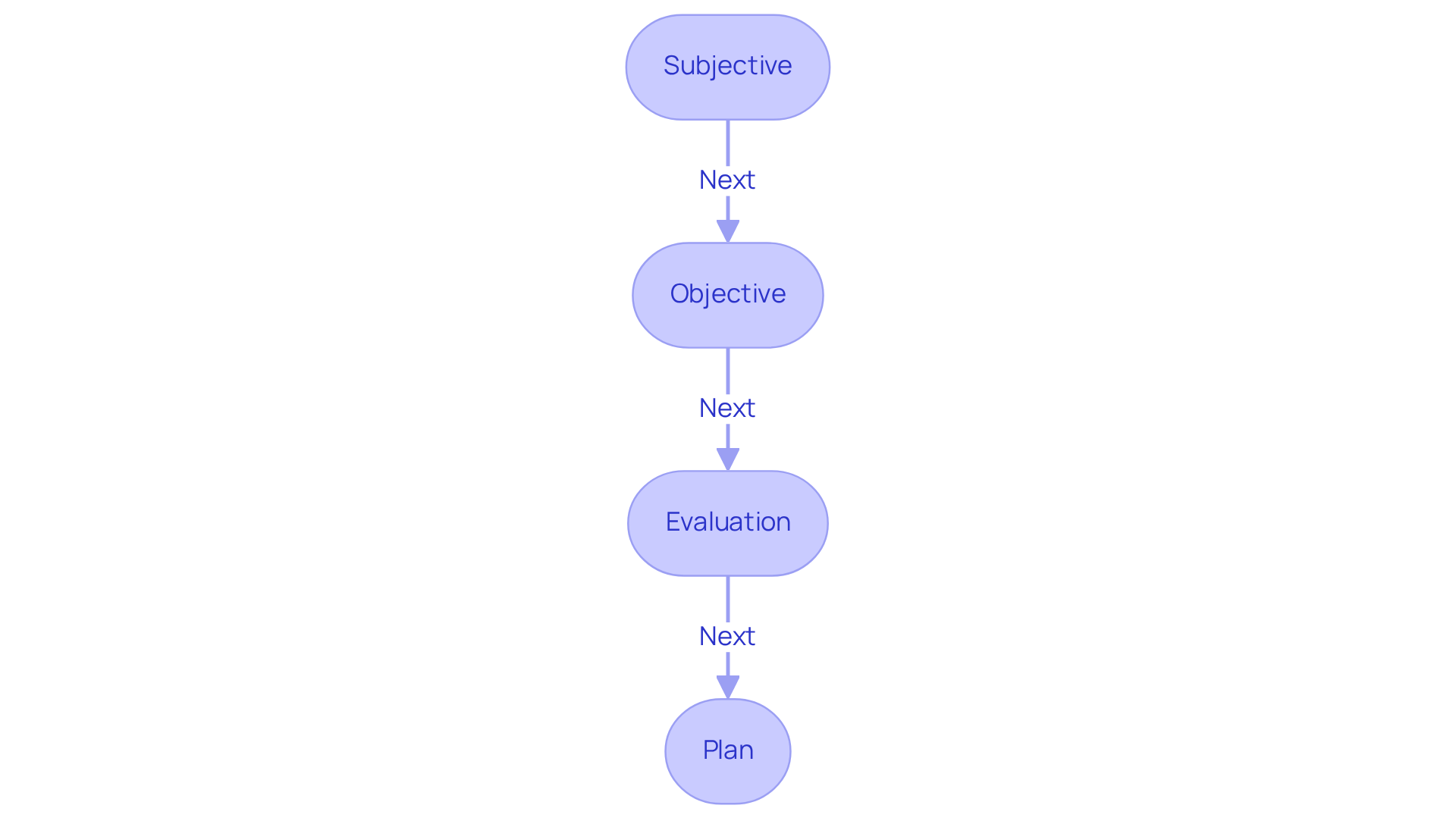
Example 2: SOAP Note for Routine Dental Check-Up
Subjective: The individual shares that they have no significant oral issues but gives a dental soap note example by expressing some concern regarding occasional sensitivity in the upper left quadrant. This is a common concern, as nearly 46% of U.S. adults experience similar issues related to gum health.
Objective: Upon clinical examination, there are no visible caries, and the gums appear healthy with normal periodontal status. Radiographs confirm that there are no abnormalities. It's reassuring to note that over 90% of Americans recognize the importance of maintaining a healthy mouth by visiting the dentist regularly.
Evaluation: According to the dental soap note example, the oral examination appears normal; however, the mild sensitivity reported is likely due to enamel erosion. This condition can affect many adults, particularly those who may not consistently follow recommended oral care routines.
Plan: The plan outlined in the dental soap note example emphasizes the essential education of the patient on proper brushing techniques and the importance of fluoride exposure for cavity prevention. Fluoride varnish has been shown to reduce cavities in children by 33%, highlighting its effectiveness. We recommend a fluoride treatment to strengthen enamel and suggest scheduling the next routine check-up in six months. This proactive approach reinforces the significance of preventive care to avoid future dental issues.
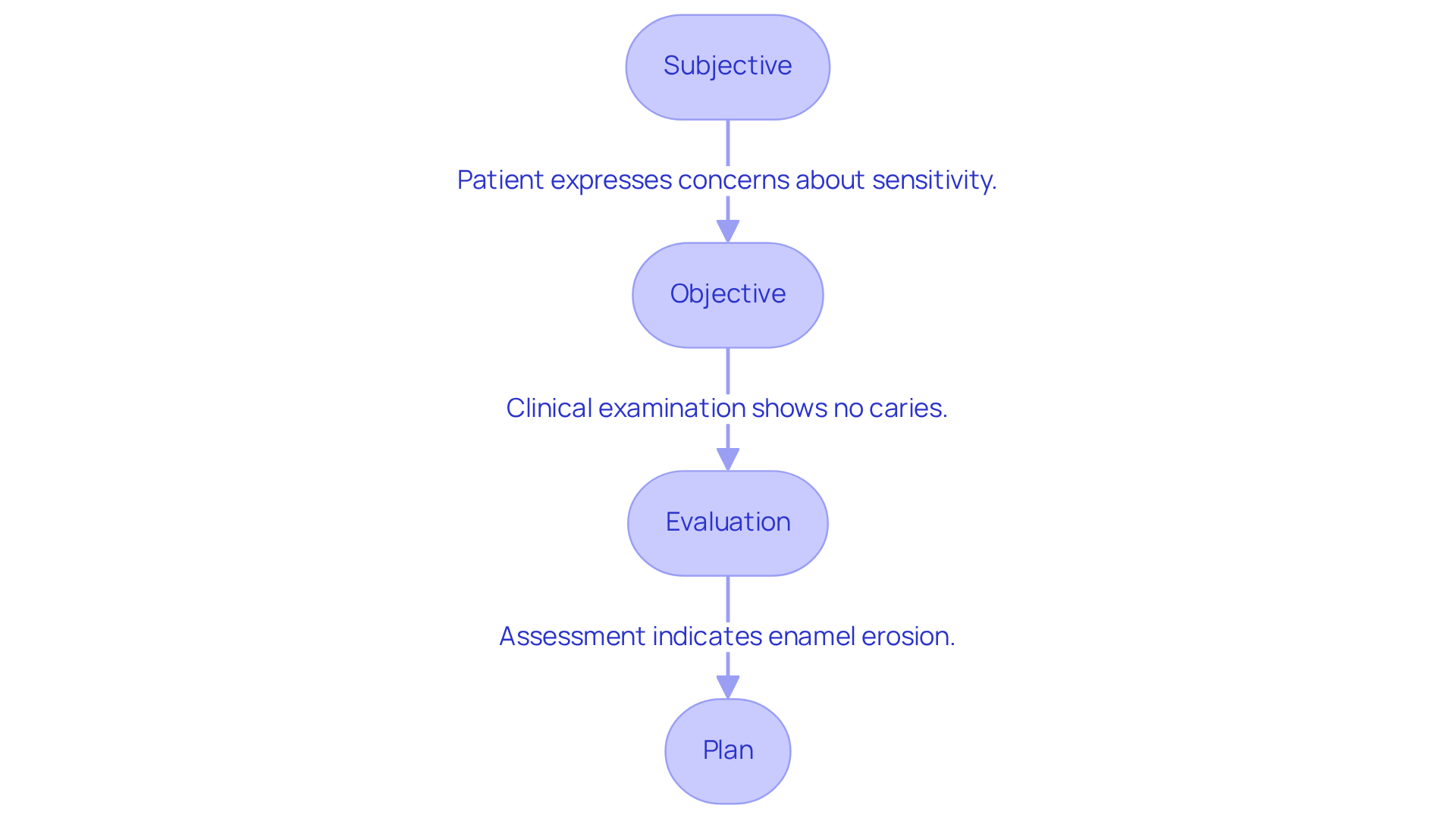
Best Practices: Writing Effective Dental SOAP Notes
To write effective dental SOAP notes, it’s important to embrace best practices that not only enhance documentation but also support your role in patient care:
- Be Concise: Clear and straightforward language is essential. By conveying information succinctly and avoiding unnecessary jargon, you help ensure that your notes are easily understood. Research shows that organized documentation can elevate the quality rating of records from 64.35 to 77.2, underscoring the importance of clarity in your work.
- Stay Objective: Focus on recording observable facts rather than personal opinions. This approach ensures that your records accurately reflect the individual’s condition. Remember, a dental soap note example offers a clear and thorough account of each session, which is vital for providing effective care.
- Use Standardized Terminology: Consistency in terminology is crucial. It minimizes the risk of misinterpretation among healthcare providers, helping everyone on the team to understand the materials without ambiguity.
- Document in Real-Time: Write observations promptly after patient interactions to capture details accurately and comprehensively. This practice reduces the likelihood of missing important information, ensuring that your records remain precise and reliable.
- Review and Revise: Regularly audit your SOAP records for compliance and clarity. Making necessary adjustments enhances their effectiveness and ensures they meet documentation standards. It’s important to avoid repetition across various sections of the SOAP document, as this promotes clarity and efficiency.
By implementing these practices, you not only improve your documentation but also provide a better dental soap note example, thereby enhancing the quality of care you deliver to your patients. Reflect on your current processes—what small changes could make a significant difference in your documentation and, ultimately, in patient care?
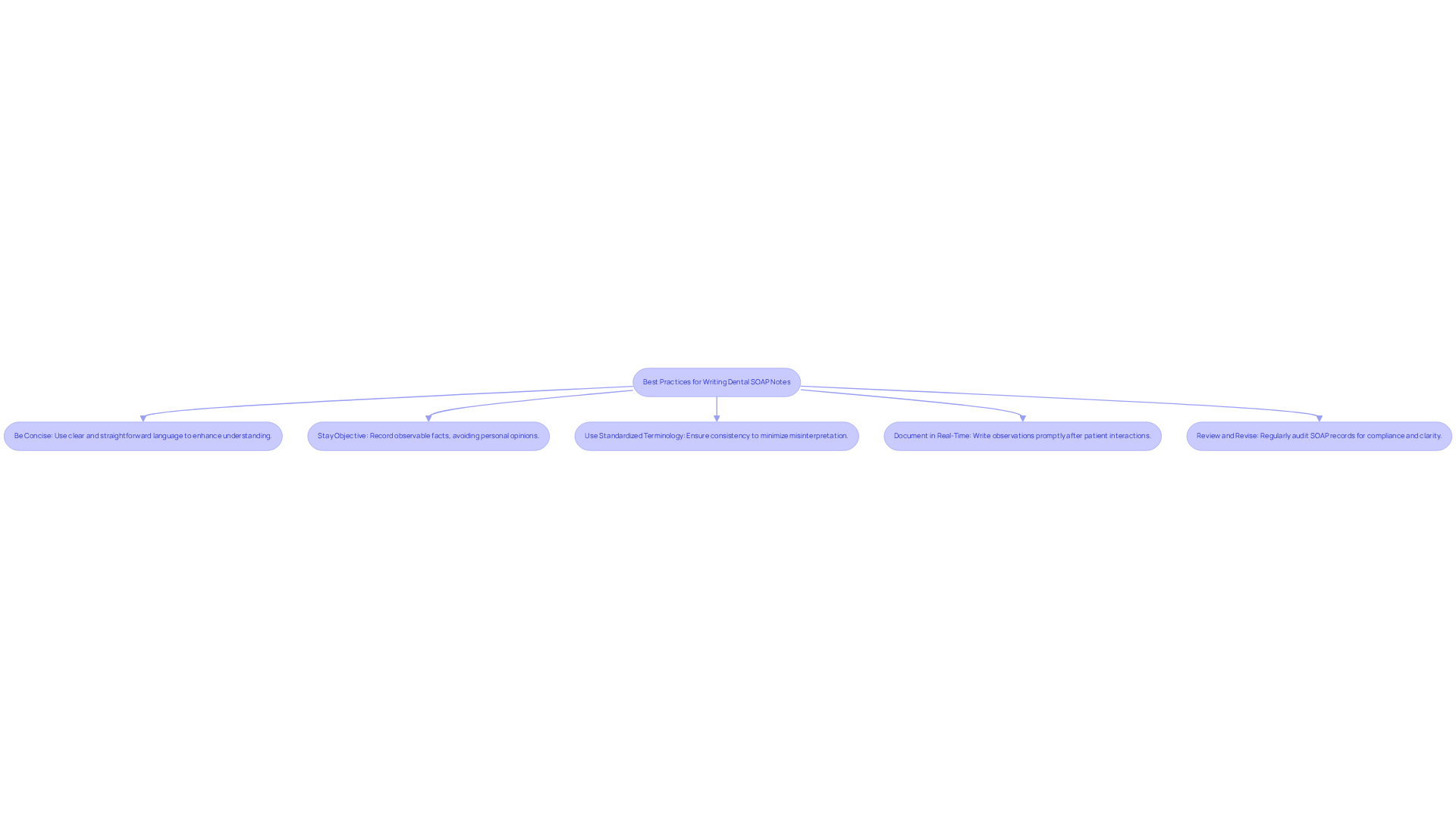
Common Mistakes: Avoiding Errors in Dental SOAP Notes
Common Mistakes: Avoiding Errors in Dental SOAP Notes
In the demanding world of healthcare, writing effective dental SOAP notes can be challenging. Many professionals face emotional hurdles when it comes to documentation. To support you in this essential task, here are some common mistakes to avoid:
- Vague Language: Using ambiguous terms can lead to misinterpretation and confusion. Instead, incorporate specific patient-reported symptoms or direct quotes to enhance clarity. As HealthOrbit AI states, "One of the most common mistakes is overgeneralising in the Subjective section."
- Incomplete Information: It's crucial to document all relevant details, including comprehensive medical history and treatment plans. Insufficient records can jeopardize care and obstruct efficient communication. In fact, documentation issues can more than double the odds that a case will close with an indemnity payment, highlighting the critical nature of thorough documentation.
- Repetition: Avoid repeating the same information across different sections. Each section of the dental soap note example should provide distinct perspectives to formulate a comprehensive evaluation of the individual's condition.
- Neglecting Follow-Up: Always include detailed follow-up plans to ensure continuity of care and client engagement. Generic follow-up statements can lead to confusion and undermine the effectiveness of treatment. Remember, documentation errors can lead to misleading conclusions and potentially harm patient care, making it essential to be precise and thorough.
To enhance your record-keeping practices, consider adopting structured templates or tools, like a dental soap note example from HealthOrbit AI. These resources can significantly improve the quality and precision of your SOAP entries, ultimately benefiting both you and your patients.
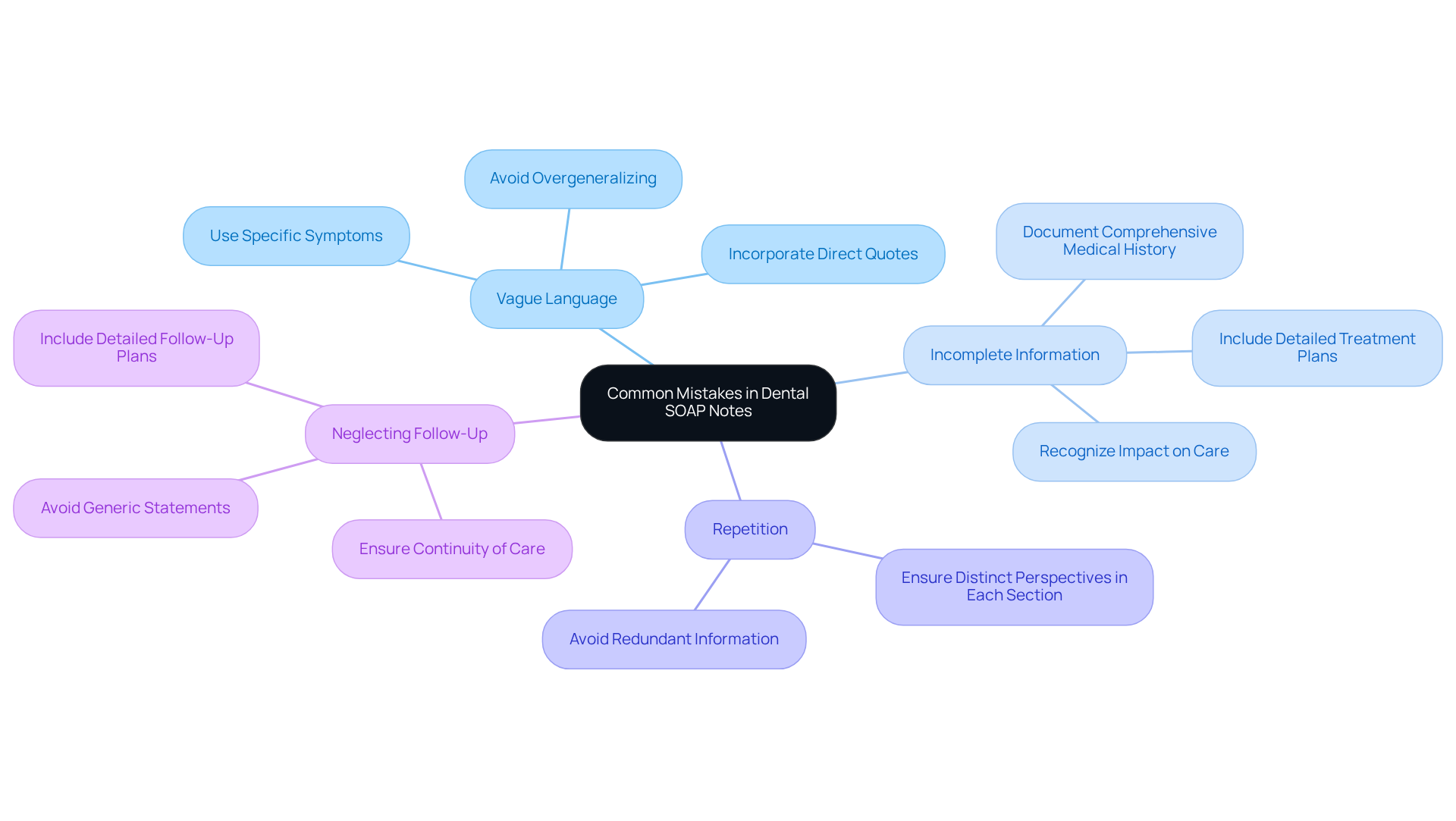
Integrating AI Tools: Enhancing SOAP Note Documentation
Incorporating AI tools into the record-keeping process can truly transform the experience for healthcare providers. Many are burdened by administrative tasks that detract from their ability to connect with patients. Imagine a world where data entry is automated, allowing you to focus on what truly matters—your clients.
AI-driven platforms ensure that all pertinent information is captured accurately and promptly. Features like voice recognition and real-time transcription simplify the record-keeping process, alleviating some of the stress that comes with documentation. This not only enhances the quality of the dental soap note example but also provides you with more time to engage with your patients.
Moreover, AI can analyze historical records to suggest improvements and ensure compliance with best practices. This means you can raise the overall quality of care for individuals. For instance, practices utilizing AI for documentation have reported a remarkable 91% reduction in processing time. This significant change allows clinicians to dedicate more time to patient engagement, fostering a more patient-centered approach in healthcare.
As we navigate the challenges of innovation in the healthcare industry, embracing these tools can help us overcome resistance and enhance the precision of our documentation. Let’s take this step together, focusing on what matters most—providing compassionate care to those we serve.

Compliance: Ensuring Regulatory Standards in Dental SOAP Notes
Navigating compliance in a dental soap note example can be daunting for dental practitioners. It's essential to understand the emotional strain that comes with adhering to regulations like HIPAA and state-specific guidelines. Maintaining patient confidentiality and accurately documenting necessary information are not just legal obligations—they are integral to fostering trust and ensuring quality care.
Practitioners often feel overwhelmed by the administrative burdens that can detract from patient interactions. However, consistent training on compliance standards and record-keeping practices can help alleviate some of this pressure. By staying updated, dental professionals can focus more on their patients and less on potential legal issues.
Utilizing compliant documentation software is another effective solution. This technology not only streamlines the documentation process but also significantly reduces the risk of errors. Imagine having a system that simplifies your workflow, allowing you to dedicate more time to what truly matters—your patients.
Consider these key benefits of compliant documentation:
- Enhanced patient trust through confidentiality
- Reduced anxiety about audits and legal issues
- More time for patient care and less on paperwork
If you're feeling the weight of compliance, remember that you’re not alone. Embracing these solutions can transform your practice and improve your connection with patients. Let's take steps together towards a more compliant and compassionate dental practice.
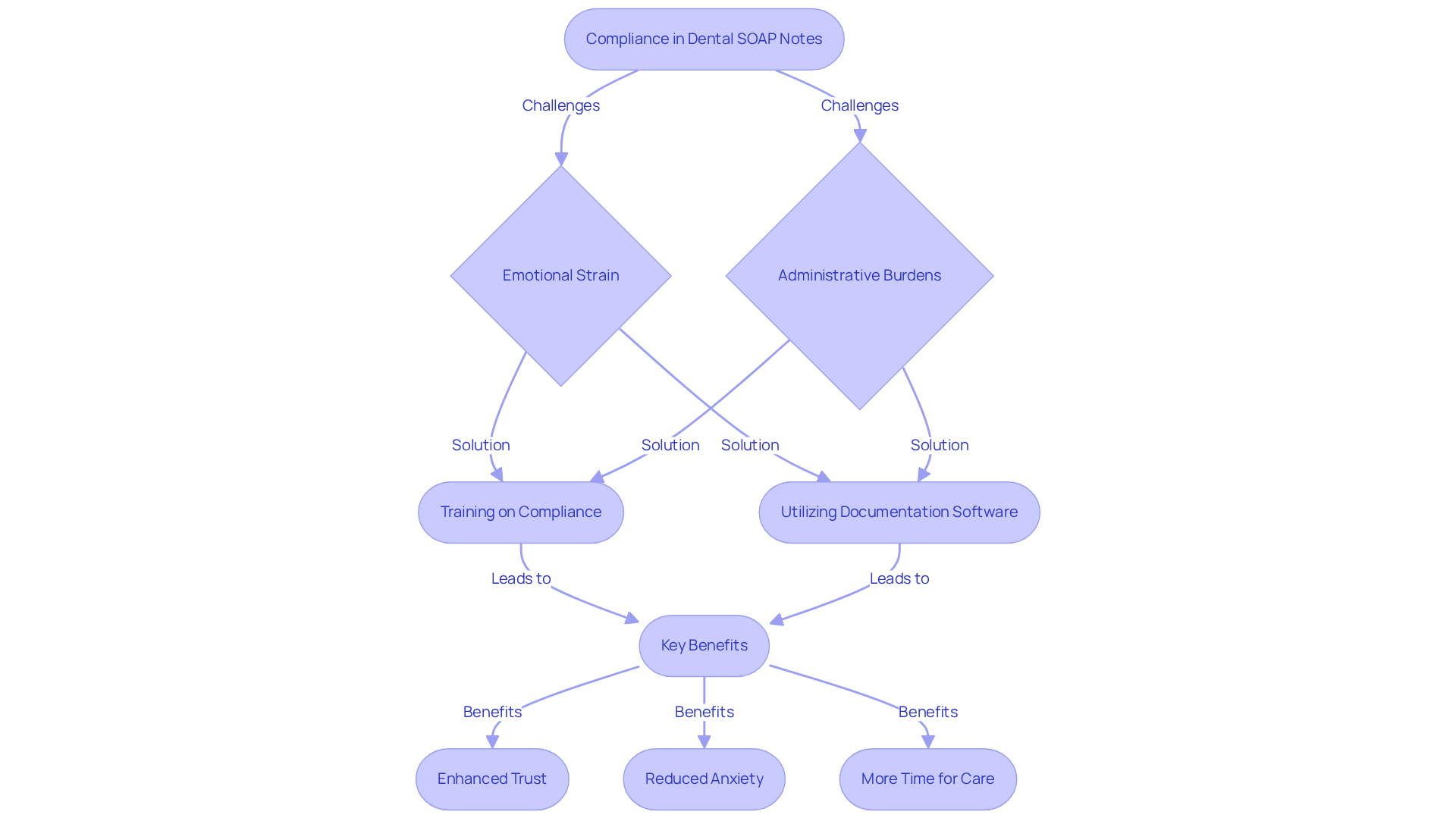
Patient Education: Documenting Instructions in SOAP Notes
Recording healthcare education in SOAP notes is essential for ensuring individuals truly understand their treatment plans and follow-up care. Have you ever considered how vital it is to clearly outline instructions in the Plan section? This includes:
- Oral hygiene practices
- Dietary recommendations
- Follow-up appointments
By documenting the individual's understanding of the information provided, we can identify areas that may need further clarification.
Research shows that effective client education significantly enhances treatment adherence. Structured goal-setting is particularly associated with higher compliance rates. For instance, individuals who set long-term health objectives often demonstrate improved compliance. This underscores the importance of clear communication in fostering a successful healthcare journey.
Moreover, efficient record-keeping not only boosts client involvement but also serves as a legal account of the information exchanged. This strengthens our commitment to client-focused care. As one nurse educator insightfully noted, "When patients ask questions, I know they’re listening." This highlights the importance of fostering an interactive dialogue during patient education.
In summary, let’s prioritize effective communication in our practice. By doing so, we can enhance understanding, improve adherence, and ultimately provide better care for our patients.
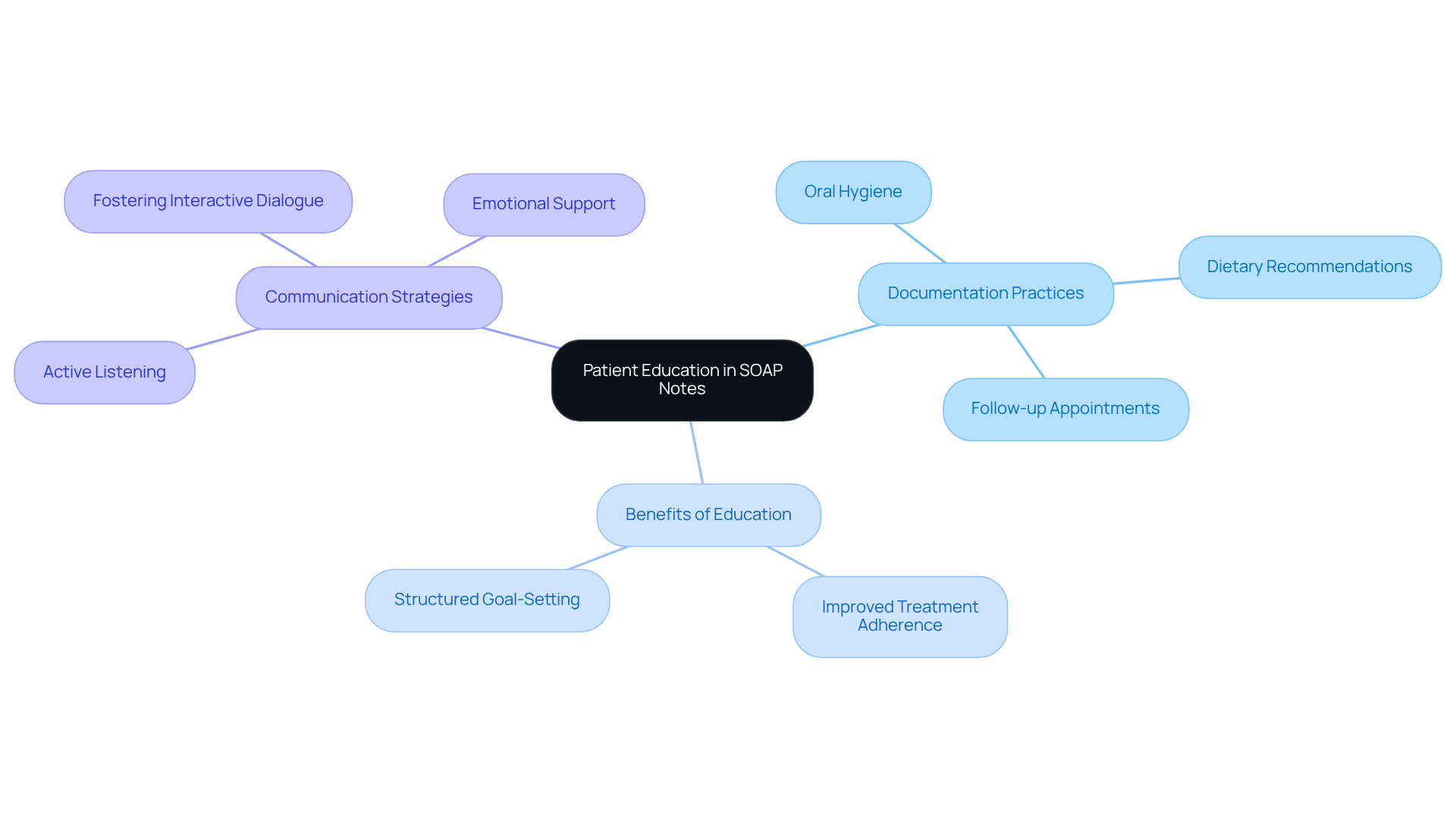
Future Trends: Innovations in Dental SOAP Note Documentation
The future of oral health SOAP note recording is poised for significant transformation, driven by innovations in artificial intelligence (AI) and machine learning. These technologies promise to create more intuitive resources that adapt to user behavior, offering real-time recommendations for improvement. As telehealth becomes increasingly integrated into oral care practices, the demand for advanced record-keeping techniques that effectively manage remote client interactions will grow.
Consider this: 80% of Americans believe that AI can enhance healthcare quality, reduce costs, and improve accessibility. This belief underscores the importance for practitioners to stay informed about these trends, refining their record-keeping practices to ultimately enhance patient outcomes. Moreover, machine learning excels at analyzing visual data, such as X-rays and 3D models, which is set to improve diagnostic accuracy and operational efficiency, revolutionizing the approach to oral documentation.
As Lou Shuman states, "AI scribes like DentalBee ensure that critical information is never overlooked." Embracing these innovations is crucial for dental professionals who aspire to elevate their practice in an ever-evolving healthcare landscape. Yet, it is essential to recognize that some patients and providers harbor concerns regarding AI's reliability and transparency. Addressing these concerns is vital as we integrate these technologies into our practices.
In summary, the journey towards enhanced oral health documentation is not just about technology; it's about improving the patient experience and outcomes. Let's engage with these advancements together, ensuring that we address both the benefits and the concerns that arise in this new era of healthcare.
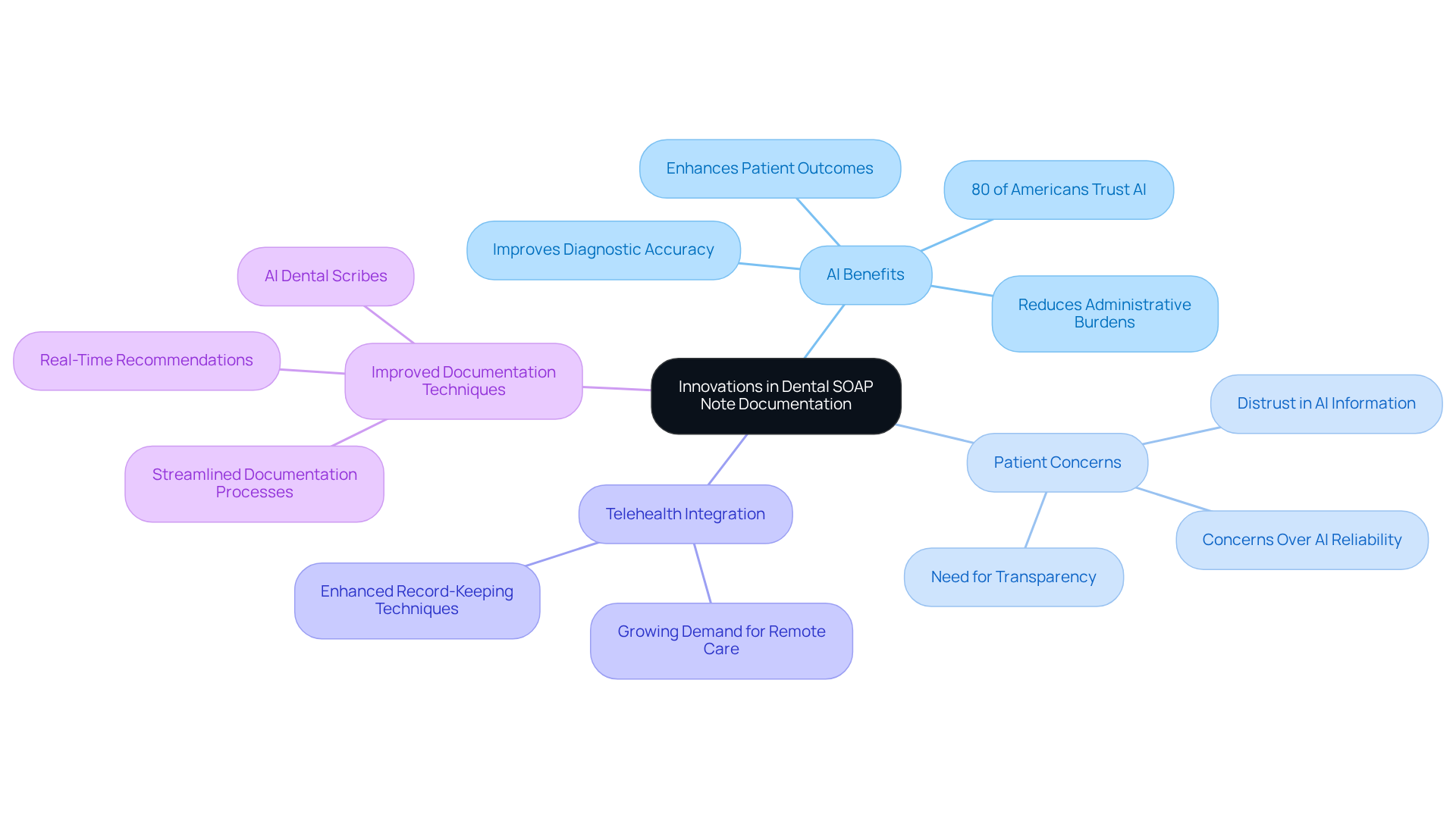
Conclusion
The evolution of dental SOAP notes marks a significant shift in how healthcare providers document patient interactions and treatment plans. This change is not just procedural; it speaks to the heart of patient care. By adopting the structured SOAP framework, dental professionals can enhance their documentation practices. This ensures that records are not only comprehensive but also clear, ultimately leading to improved patient care. Moreover, integrating AI technology, such as CosmaNeura, streamlines this process, allowing practitioners to devote more time to their patients rather than getting overwhelmed by administrative tasks.
Throughout this article, we have shared key insights about the importance of clear and concise documentation. We've explored the role of AI in boosting efficiency and discussed best practices to help avoid common pitfalls in SOAP note writing. It’s crucial to emphasize patient education and compliance with regulatory standards. These elements underscore the necessity for thorough and accurate records, which not only facilitate better care but also protect both patients and providers legally.
As the dental industry continues to innovate, it’s vital for practitioners to stay informed and adapt to these changes. By embracing AI and refining documentation practices, significant improvements in patient outcomes and overall practice efficiency can be achieved. Taking proactive steps now will ensure that dental professionals are well-prepared to navigate the future of healthcare documentation. This, in turn, fosters a more compassionate and effective patient experience.
Are you ready to embrace these changes and enhance your practice? Your commitment to adapting can make a profound difference in the lives of your patients.




